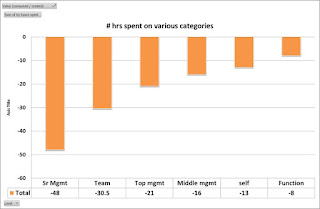In the corporate environment,
change of job either by joining a new organization or job rotations is
important and inevitable. These changes
(new person in a new role) helps the individual to learn / contribute in the
organization and also gives a fresh perspective to the function.
My questions to the hiring manger
are, when we get a new person to the new role (internal or external hire),
- - are we expecting the person jump start and
produce results ?
- - are we giving her enough time to settle down ?
- - are we allocating resources in educating about
the org / role ?
- - do we have sufficient self-learning material?
I I feel as a hiring manager we
need to spend quality time with the “new hire” on induction, not just for the
job role, also about the group, organization, people, culture, processes,
decisions, goals, etc. I often see Managers
are in a rush to deploy the person into the role (billable project or
otherwise) and expect the person to produce value (results) quickly and allow a
natural path of long learning cycle about the rest of the organization.
I am sharing my experience when I
joined this organization little more than three years ago. I was joining this company after a long stint
of 22 years in my previous organization;
I had some butterflies in my stomach.
I also knew in the new role, I will be inducting lot of leaders and
hence decided to watch my transition bit more granular for the first 90 days.
First, I
said to myself ; in my first 90 days, I will take over from the incumbent
like a “soap bubble” and I will ensure “the
bubble” does not break. I also said, I
will neither attempt to re-size nor reshape the bubble. The meaning here is, will understand the details
on its own merits; however set aside the changes / recommendations post 90
days.
 Second, I
did jot down all my interactions with the colleagues and categorized them as “value
consumed” or “value delivered”. If I
had learnt / understood something from someone, I have categorized those
interactions as “value consumed” and given a numerical value of “minus 1” and if have I have
contributed something significant in the conversation, solutions, etc, categorized
those as “value delivered” and given a numerical value of “plus 1”. At the end
of each day, computed the cumulative net value delivered to the organization
and plotted a graph. As expected the net
value was –ve initially and more –ve later, less –ve over a period of time, break-even and grew +ve thereafter. Interestingly, it took about seven weeks for a break-even in my
case.
Second, I
did jot down all my interactions with the colleagues and categorized them as “value
consumed” or “value delivered”. If I
had learnt / understood something from someone, I have categorized those
interactions as “value consumed” and given a numerical value of “minus 1” and if have I have
contributed something significant in the conversation, solutions, etc, categorized
those as “value delivered” and given a numerical value of “plus 1”. At the end
of each day, computed the cumulative net value delivered to the organization
and plotted a graph. As expected the net
value was –ve initially and more –ve later, less –ve over a period of time, break-even and grew +ve thereafter. Interestingly, it took about seven weeks for a break-even in my
case.
Third, I
have broken down the net value further by functions (ex: Delivery, pre-sales,
Talent acquisition, etc). The
observation here is, some of the function had a more +ve net value and some of
had more –ve net value at the end of 90 days. I am not advocating more positive is good or
more negative is bad. The point, I am driving is depends on the
role we are hiring the person, if we can steer the induction we may get better
results.
Fifth, I had jotted down my recommendations on what we need to do
better; more from an “outside-in” perspective and did present this to my
mangers after about 120 days of joining the organization. My
managers not only appreciated those views, also given me green signal to
implement some of those and I am glad to say more the three-fourths of these
ideas are implemented.
My transition has given me
learning on hiring and inducting people in new roles, the key ones are
1 1) Allow
new hire to understand the organization beyond the job role (don’t break the soap
bubble).
2 2) Focus
the transition on the key areas beyond the job role as well.
3 3) Allocate
time and resources for transition (including the hiring manger’s time).
4 4) Motivate
the person to get fresh perspective (outside-in) in the early days, before s/he
get used the organization. Recognize good
ideas and explore implementation.
5 5) Create
self-reading material.
Thank you for reading this,
looking forward for your comments.



